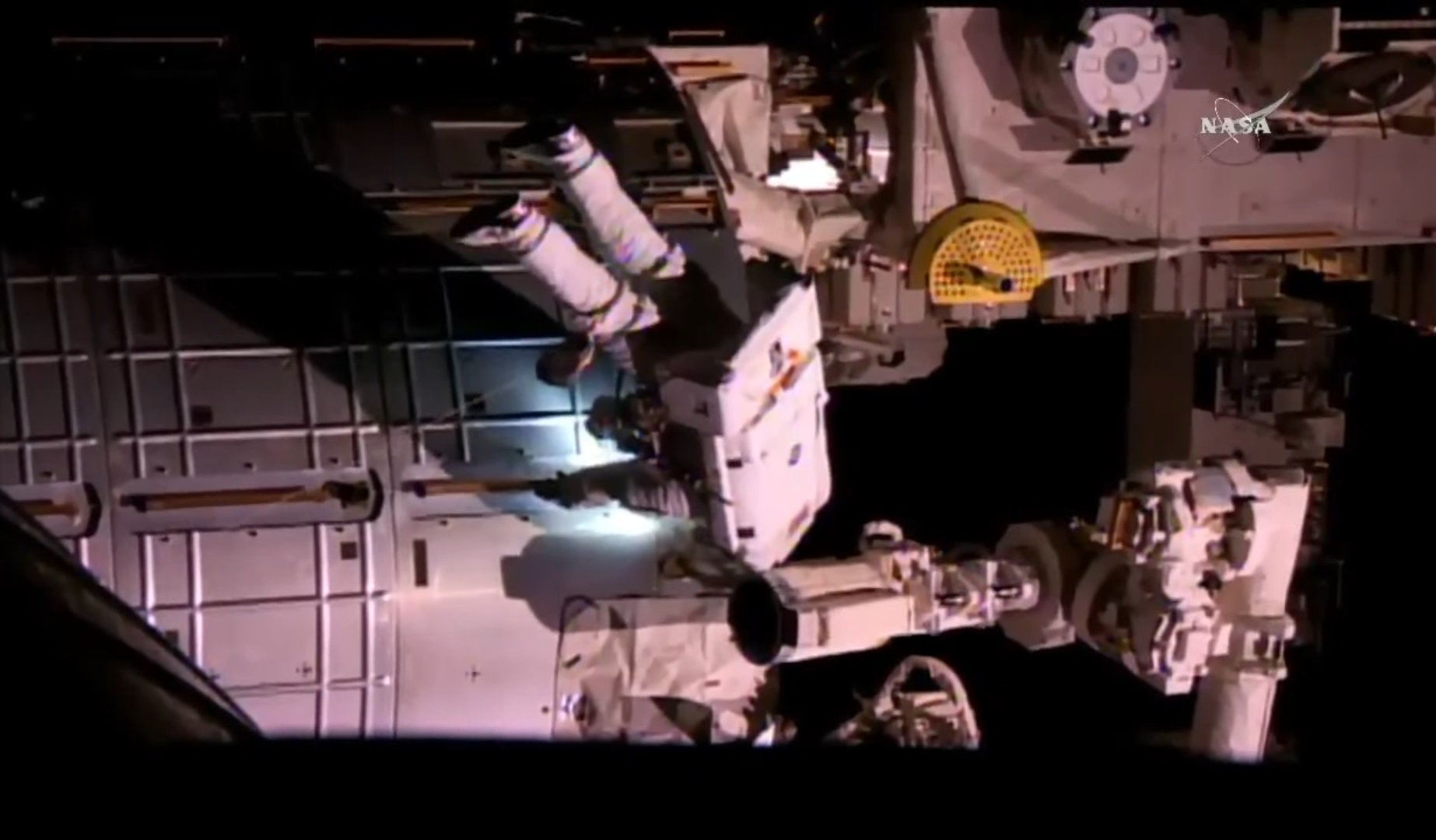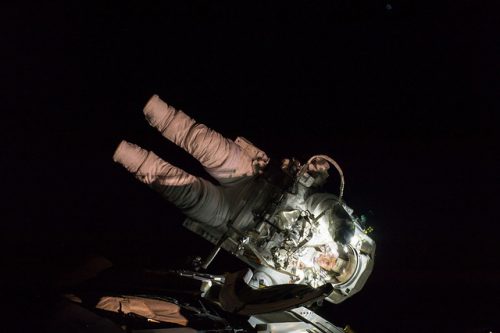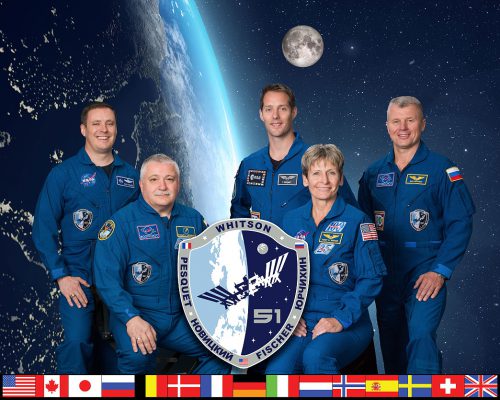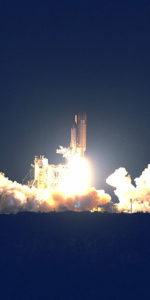
For the fifth time in as many months in 2017, a pair of astronauts ventured outside the International Space Station (ISS) earlier today (Friday, 12 May), tasked with a broad range of objectivess, including the removal and replacement of an avionics box and the installation of data connectors, protective shielding, a new high-definition camera and a pair of wireless antennas. Expedition 51 Commander Peggy Whitson—who already stands as the world’s most experienced female spacewalker—and Flight Engineer Jack Fischer spent an abbreviated four hours and 13 minutes outside the station. Returning inside after the historic 200th Extravehicular Activity (EVA) of the ISS era, Whitson retains her previous position as the fifth most seasoned spacewalker in the world.
As previously outlined by AmericaSpace, U.S. EVA-42—the 42nd spacewalk in U.S.-built space suits, performed in the absence of the Space Shuttle—was originally baselined as part of a group of three excursions in the late March and early April timeframe, involving Whitson and her Expedition 50 crewmates Shane Kimbrough and Thomas Pesquet. However, one of EVA-42’s key priorities was the removal and replacement of an ExPRESS Pallet Controller Assembly (ExPCA), an avionics box responsible for powering electrical and data connections to various science payloads aboard the ISS. The new ExPCA was scheduled to fly to the station aboard Orbital ATK’s OA-7 Cygnus cargo ship in late March, but its launch was delayed and did not ultimately take place until 18 April.
The spacewalk was correspondingly moved into the first half of May, after the arrival of U.S. astronaut Jack Fischer aboard Soyuz MS-04. Had it taken place in April, U.S. EVA-42 would have been performed by Whitson and Pesquet, but NASA decided to assign Fischer instead. Having previously performed a pair of spacewalks in January and March, totaling more than 12.5 hours, Pesquet stepped aside to allow Fischer to make the first EVA of his career. This allows the International Partners to “spread the wealth” of spacewalking expertise across the corps. As a result, Pesquet remained inside the station for U.S. EVA-42, operating the 57.7-foot-long (17.6-meter) Canadarm2 robotic arm.

Over the last couple of weeks, the Expedition 51 crew has embarked on detailed EVA preparations, reviewing procedures via the Dynamic On-board Ubiquitous Graphics (DOUG) software, performing procedures and timeline reviews, configuring tools and cuff checklists and preparting the station’s Quest airlock for operations. They also checked out their space suits—Extravehicular Mobility Unit (EMU) #3008, to be used by Whitson, and EMU #3006, for Fischer—which included scrubbing the coolant loops, filling water bags and installing batteries and carbon-dioxide-scrubbing lithium hydroxide canisters. Ever enthusiastic, a fully-suited Fischer donned and fit-checked EMU #3006. “Test-driving my space suit for a walk outside on Friday with @AstroPeggy,” he tweeted on Tuesday, 9 May. “I don’t think I can smile any bigger—well, maybe I will on Friday!”
The list of tasks for Whitson and Fischer during their 6.5 hours outside the station was topped by the installation of the ExPCA onto the S-3 segment of the Integrated Truss Structure (ITS). The astronauts were also assigned to install the 1553 Terminator to route data to the Alpha Magnetic Spectrometer (AMS), together with a protective Forward Shield on Pressurized Mating Adapter (PMA)-3—which was relocated from the Tranquility node to its current perch at the space-facing (or “zenith”) face of the Harmony node in late March—and a high-definition camera and a pair of wireless antennas.
Assisted by Expedition 51 crewmates Thomas Pesquet and Oleg Novitsky, the spacewalkers donned their suits in the Quest airlock, early Friday, and spent about 60 minutes “pre-breathing” on masks. The inner equipment lock was depressed from its ambient 14.7 psi to 10.2 psi, allowing Whitson and Fischer to check and purge their suits. It was then repressurized back up to 14.7 psi, allowing them to undertake a nominal pre-breathing regime, followed by 50 minutes of In-Suit Light Exercise (ISLE).
However, it was at this juncture that U.S. EVA-42’s first major issue arose. Ordinarily, the astronauts’ suits receive electricity, cooling and communications via Service and Cooling Umbilicals (SCUs) during the pre-breathing period. Unfortunately, the SCU connected to Fischer’s suit experienced a small water leak, requiring the pair to share the other SCU. NASA stressed that the leak was in the SCU, and not in Fischer’s suit, but the sharing process caused an additional draw in battery power on the EMUs. This limited the battery power available for use during the spacewalk itself and U.S. EVA-42 was accordingly reduced in duration from 6.5 hours to around four hours.
In response to this issue, the ExPCA removal and replacement was assigned as the primary objective of the spacewalk, with the possibility of moving into the other tasks as “get-aheads”, if the opportunity presented itself. Shortly before 8:30 a.m., Pesquet and Novitsky transferred the fully suited pair from the equipment lock into Quest’s outer crew lock and closed the connecting hatches. Depressurization of the crew lock got underway a few minutes later and reached a condition of near-vacuum a few minutes after 9 a.m. Whitson and Fischer transferred their suits’ critical life-support utilities to battery power and U.S. EVA-42 officially began at 9:08 a.m.
Embarking on her ninth career spacewalk—a record for a woman—Whitson was first to depart the airlock, followed by Fischer, who became the 217th person and the 130th American to venture outside his vehicle in space. As is customary immediately after egress, the duo set to work on “buddy checks” of each other’s suits, tethers, tools, gloves and Helmet Absorption Pads (HAPs).

The spacewalkers headed directly to their worksite on the Earth-facing (or “nadir”) face of the station’s S-3 truss segment and had removed the old ExPCA a little over an hour into the EVA. So swift was their progress than the new ExPCA was in place and activated by 10:50 a.m. and, in spite of Fischer’s limited suit battery life, the duo were reassigned the original U.S. EVA-42 tasks of fitting the 1553 Terminator onto the AMS, tying down multi-layered insulation on the robotic arm of Japan’s Kibo lab and installing the Forward Shield (nicknamed the “cummerbund”, due to its shape) onto PMA-3.
With the bulk of their original objectives squeezed into a spacewalk whose length had been shortened by a quarter, a triumphant Whitson and Fischer headed back to the Quest airlock and wrapped up U.S. EVA-42 at 1:21 p.m. EDT, after four hours and 13 minutes. The shortened nature of the today’s excursion meant that Whitson lost her chance to rise from the world’s fifth most experienced spacewalker into third place and she currently boasts a career total of 57 hours and 35 minutes, just 20 minutes shy of fourth-place-holder Jerry Ross.
And the link between Whitson and Ross is interesting, for as Ross led the very first EVA to begin ISS construction, way back in December 1998, so Whitson today led the 200th. All told, in those 200 spacewalks, no fewer than 122 men and women from nine sovereign nations—the United States, Russia, Canada, France, Japan, Germany, Sweden, Italy and the United Kingdom—have toiled for 1,247 hours and 55 minutes outside the station.
Virtually half of all the spacewalks done since March 1965 have been done at the ISS. Forty-two have been conducted in U.S. suits, from the Quest airlock and without the presence of the Space Shuttle, whilst a further 49 have originated from the station’s Russian Orbital Segment (ROS). In addition, 109 EVAs were performed in the presence of the shuttle between December 1998 and July 2011.
Those spacewalks have set in place all of the key elements of the ISS infrastructure, from the Unity, Harmony and Tranquility nodes to the U.S. Destiny, European Columbus and Japanese Kibo labs and from the gigantic truss structure—laden with four sets of electricity-generating Solar Array Wings (SAWs), radiators and associated cooling hardware—to the multi-windowed cupola. In May 2011, spacewalkers Mike Fincke and Greg Chamitoff brought the total amount of EVA time devoted to ISS construction and maintainence to just over 1,000 hours.
Spacewalkers have also installed replacement hardware and responded to potentially serious contingencies, including ammonia leaks and the intrusion of water into a space suit helmet. Other issues of a more irritating nature have ranged from the loss of tools, including a Crew Lock Bag which got away from U.S. astronaut Heidemarie Stefanyshyn-Piper in November 2008, the loss of Micrometeoroid Orbital Debris (MMOD) shielding by Shane Kimbrough in March 2017 and damaged space suit gloves.
Those EVAs have set and re-set numerous empirical and national records. It interesting to note that Whitson was outside the station in December 2007 for the 100th EVA dedicated to ISS construction and maintenance. A record for the longest EVA in history was also set during the marathon ISS construction effort. In March 2001, Expedition 2 astronauts Jim Voss and Susan Helms spent eight hours and 56 minutes outside the station; a record which still stands to this day.
Be sure to “LIKE” AmericaSpace on Facebook and follow us on Instagram & Twitter!





